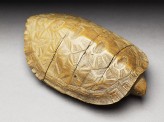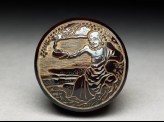The Ingrams in Japan
A story about Sir Herbert and Lady Ingram’s honeymoon in Japan, where they collected hundreds of objects now in the Ashmolean’s collection.

Tokyo and around
Several days in the capital of Tokyo caused Mr Ingram to write ‘everything very expensive here’. However, they did hunt down few lovely things, among them the only inrō in the collection to be decorated on the inside risers (EA1956.1745). The night scene of herons roosting in cryptomeria trees silhouetted beneath a crescent moon is reminiscent of paintings by the artists of the Nihonga movement.
 Inrō with egrets and trees under a crescent moon (EA1956.1745)
Inrō with egrets and trees under a crescent moon (EA1956.1745)
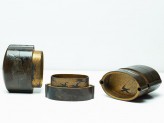 Detail of inrō with egrets and trees under a crescent (EA1956.1745), This shows the risers on the inside of the inrō.
Detail of inrō with egrets and trees under a crescent (EA1956.1745), This shows the risers on the inside of the inrō.
Nikkō
Few foreign visitors to Japan at that time missed a trip to one of the most iconic sights in the country, the mausoleum of the first Tokugawa Shogun, Ieyasu, and its surrounding buildings located in Nikkō, 80 miles to the north of Tokyo. Set in a forest of tall cryptomeria trees, the buildings are very atmospheric and Mr Ingram reports in his diary, 'this was a long way the finest Jap[anese] temple we had seen [and] beautifully situated - the decorations were extremely fine tho' too brightly coloured'. (Many of the buildings at Nikkō are decorated in Chinese colours, rather than the unpainted wood of typical Japanese shrines, and the columns are lacquered in bright vermillion red).
Once again the 'curio' shops beckoned and in one afternoon twenty items were purchased, among them a charming wooden turtle-shaped inrō (EA1956.3295), by Kokaku, a carver who seems to have specialised in this animal and the gold ojime (EA1956.3792) which cost more than twice the turtle inrō
Karuizawa
A transport hitch caused the Ingrams to stay an unscheduled night in Takasaki on their way to Karuizawa, a spa town, much favoured by foreign residents for its cooler summer temperatures. There must have been a shop in Takasaki for the catalogue records six items, including this small lacquer box showing the rakan, Handaka Sonja (EA1956.1792). Among other attributes, he is said to have been able to subjugate dragons, and is shown here holding a bowl issuing forth a stream of smoke, representing the dragon which the artist has carved around the side of the box.
From Karuizawa, Mr Ingram undertook an arduous climb up the active volcano, Mount Asama. Unbeknown to him, there had been a bad earthquake three days before, which had caused new fissures to appear in the crater of the volcano. Mr Ingram's diary reports tremendous noise and dense sulphurous fumes issuing forth which 'prevented us from seeing in, tho' we stood at its edge [and] were nearly suffocated for our pains'.
Yokohama
The following day, the Ingrams returned to Yokohama where they read about the earthquake in the newspaper. The final days were spent packing and preparing their treasures for shipping, but not without adding a further 80 objects to their collection. This included another dozen Satsuma pieces bought through Matsuzawa from the sumo wrestler, and which brought the total to nearly 100 pieces.
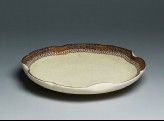 Satsuma plate with geometric border (EA1956.669)
Satsuma plate with geometric border (EA1956.669)
 Satsuma sake kettle with geometric bands (EA1956.696)
Satsuma sake kettle with geometric bands (EA1956.696)
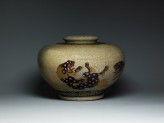 Vase depicting three playing shishi, or lion dogs (EA1956.405)
Vase depicting three playing shishi, or lion dogs (EA1956.405)
These three Satsuma pieces were from the Sakahoko collection.
Two shops famous for their high-quality art were mentioned in the catalogue. Samurai Shōkai, whose splendid entrance was topped by an eagle with outspread wings, was well known in Yokohama. It was owned by a man named Nomura Yūzō. In his desire to perpetuate Japanese traditional crafts he would commissions artists to make pieces using the old time-consuming methods and sell them in his emporium. The inrō with chickens and begonias (EA1956.1743) may have been one of these pieces for it is unsigned and yet there are two others of identical design by Jittokusai Gyokuzan, a fine late Edo period lacquerer (one of which is now in the collection of The Walters Art Museum, Baltimore, the other formerly in the Lawrence Collection).
Mrs Ingram added several ojime to her collection in Samurai Shōkai, and from the other well-known dealer, Arthur Bond, she bought her final four.
Scattered among the entries in their purchase catalogue are several entries for kozuka (knife handles), of which an enormous collection came with the Ingram donation. It is hard to identify them clearly, since many are not numbered, but here are a few from the collection which are also on display in the Japan from 1850 gallery:
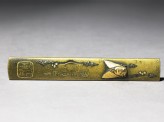 Kozuka, or knife handle, with a cicada (EA1956.2913)
Kozuka, or knife handle, with a cicada (EA1956.2913)
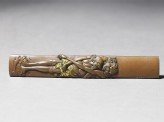 Kozuka, or knife handle, depicting Ashinaga and Tenaga (EA1956.2912)
Kozuka, or knife handle, depicting Ashinaga and Tenaga (EA1956.2912)
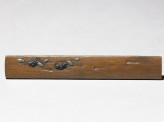 Kozuka, or knife handle, with ants (EA1956.2957)
Kozuka, or knife handle, with ants (EA1956.2957)
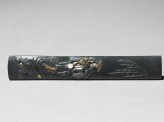 Kozuka, or knife handle, with an oni carrying the Wisteria Maiden (EA1956.2906)
Kozuka, or knife handle, with an oni carrying the Wisteria Maiden (EA1956.2906)
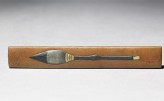 Kozuka, or knife handle, with calligraphy brush (EA1956.2917)
Kozuka, or knife handle, with calligraphy brush (EA1956.2917)
On the 3 June the 'fine boat' Mongolia set sail for Adelaide with the Ingrams on board. Mr Ingram's diary reports, 'Matsuzawa came to see us off and gave us a rose in a pot and some sponge cake'.
After their honeymoon, the young Ingrams returned to Gloucestershire to live at Driffield Manor, a large Cotswold stone manor house, where they brought up their three children. After the First World War, Mr Ingram's collecting activities strayed from Japanese to Chinese works, and to ceramics in particular. Slowly but surely he amassed the vast collection of early greenwares that also came to the museum with his Japanese objects. In an obituary the Ashmolean Museum's Keeper of Eastern Art, Peter C. Swann wrote, 'To visit his collection in its beautiful setting near Cirencester was always a delight. He was hospitality itself to both the expert and the uninitiated. Before his health was impaired, to tour from study to drawing room, from the garages back to the "problem room" was enough to reduce a strong man to mental and physical exhaustion'. Lady Ingram studied their Japanese collection and wrote several articles for Connoisseur magazine, which were published in the 1930s. She survived her husband by 10 years.
© 2013 University of Oxford - Ashmolean Museum

